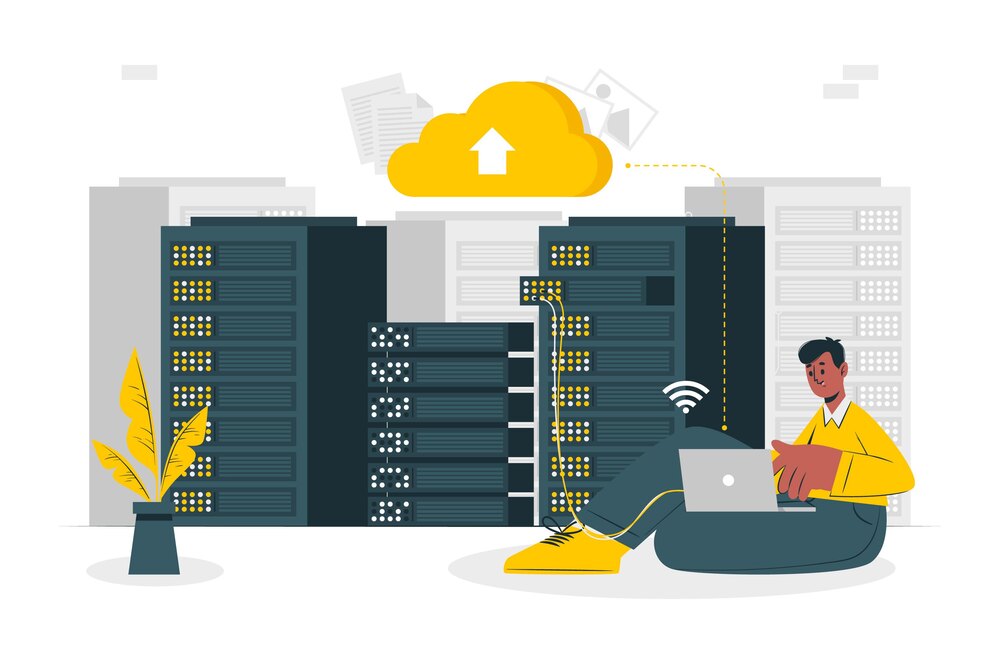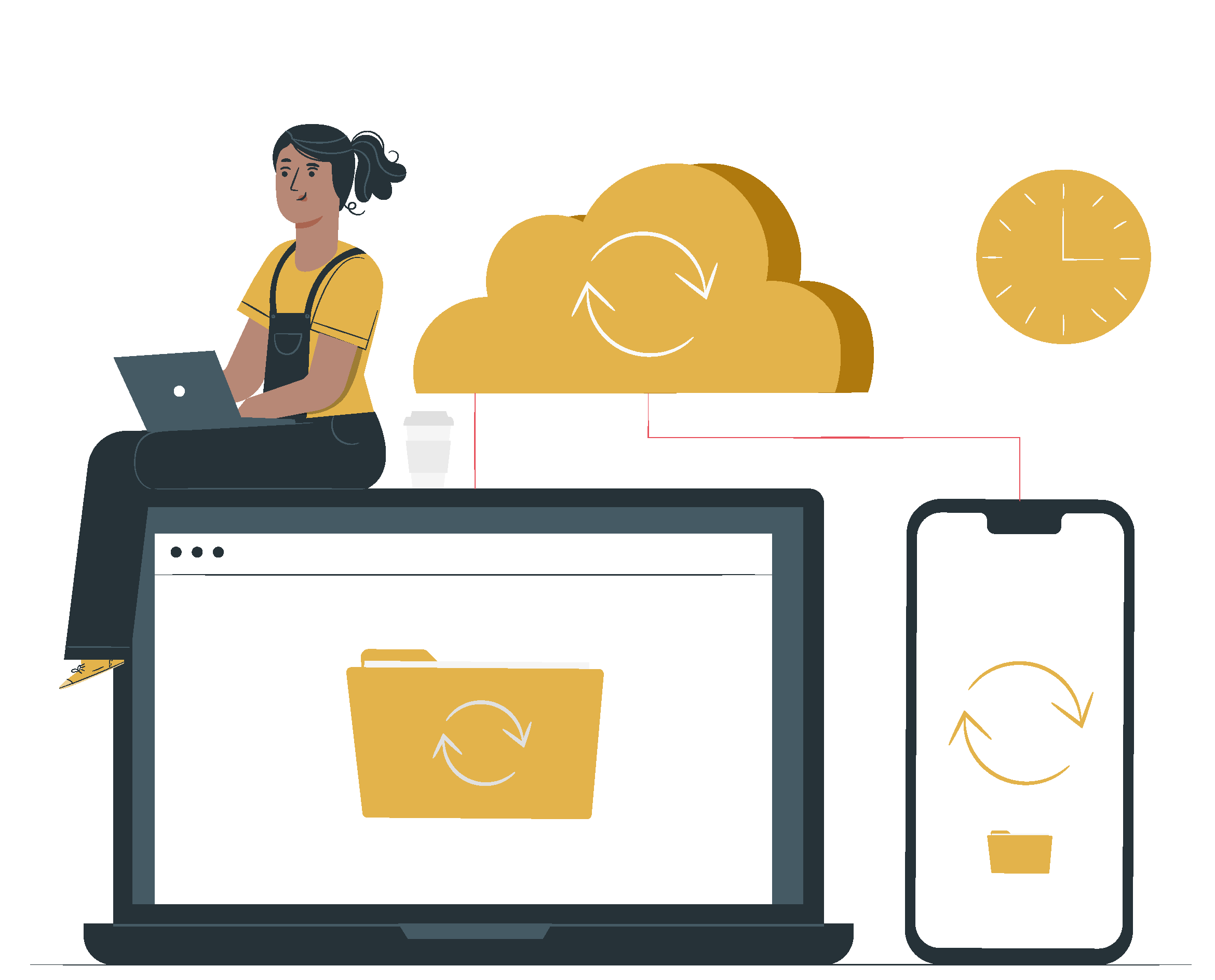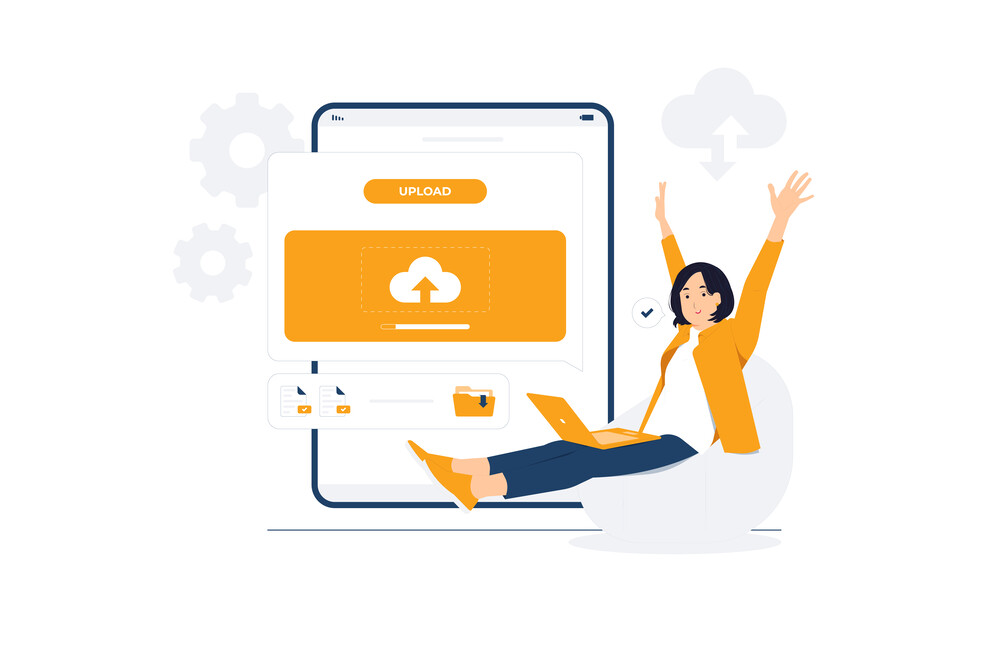
Explore how serverless computing is transforming cloud services by enabling faster development, cost efficiency, and scalability. Learn why industries like healthcare, finance, and e-commerce are adopting serverless as a key strategy for digital transformation in the cloud-first era.
Serverless computing is transforming the digital landscape by allowing developers to focus solely on writing and deploying code without needing to handle server management. This approach is a big shift from traditional methods.
Leading cloud providers like AWS Lambda and Microsoft Azure Functions offer fully managed infrastructures that automatically scale, making operations more efficient. With the growing demand for faster and more affordable cloud solutions, serverless computing is becoming a key part of the future of app development.
Understanding Cloud Computing and Its Evolution
Cloud computing is a big change from traditional servers to online services. Now, companies don’t need large in-house setups, which saves money and effort. This shift helps businesses use different services to work better and more easily.
The Basics of Cloud Computing
Cloud computing’s core is in its three main services: IaaS, PaaS, and SaaS. With IaaS, firms rent online space rather than buying hardware. PaaS lets them create apps without handling the base tech. And SaaS gives software online, often paid monthly.
Transition from Traditional to Cloud Services
Moving to cloud services brings many benefits. Companies can adjust their resources as needed, making it easier to handle changes. They save on hardware costs and maintenance. Plus, cloud computing improves updates and data safety, keeping businesses up to date easily.
| Aspect | Traditional Servers | Cloud Services |
| Initial Costs | High upfront investment required for hardware | Lower initial costs with a pay-as-you-go model |
| Scalability | Limited; requires physical upgrades | Flexible; can scale resources easily |
| Maintenance | Manual updates and management are needed | Automatic updates through service providers |
| Disaster Recovery | Complex and costly recovery plans | Integrated backup and recovery solutions |
What is Serverless Computing?
Serverless computing is a cloud service that lets developers build and manage apps with less hassle. They don’t have to stress over servers. This approach boosts how much developers can do and how efficiently they can work.
Defining Serverless Computing
Serverless computing means developers can launch apps without worrying about servers. The cloud provider handles setup and upkeep. This makes it easy to adjust the app’s size based on its needs without manual effort.
How Serverless Differs from Traditional Hosting
In traditional hosting, users manage their resources. However, serverless computing charges are based on use. It reacts to events, cuts costs, and uses resources better. Businesses can thus adapt faster to new trends.
Key Components of Serverless Architecture
The serverless architecture includes important parts that boost its use:
- Event Triggers: Actions that start serverless functions.
- Runtimes: Where serverless functions run, made for different coding languages.
- Stateless Functions: These functions don’t keep data after they run, which improves scalability and efficiency.
| Feature | Serverless Computing | Traditional Hosting |
| Management | Automated by a cloud provider | Manual server management is required |
| Cost Structure | Pay-as-you-go | Fixed monthly fees |
| Scalability | Automatic scaling | Manual scaling needed |
| Development Focus | Code-centric | Infrastructure-centric |
By understanding these components, businesses can leverage serverless to innovate and ease operational tasks.
The Role of Function as a Service (FaaS)
Function as a Service (FaaS) is a key part of serverless computing. It lets developers write simple functions that respond to events. This way, they don’t need to handle server upkeep. This greatly improves how applications are made and used.
Explaining FaaS in Serverless Computing
FaaS takes away the hard parts of hosting online. Developers can set off functions as needed, like when someone visits a webpage or uploads a file. Being a big piece of serverless computing, FaaS makes apps scale easily and adapt quickly, managing changes in traffic smoothly.
Benefits of Using FaaS
Using FaaS brings many perks for companies:
- Rapid scalability: Apps adjust automatically to more work, running smoothly under pressure.
- Cost-effectiveness: You only pay for what you use, which saves money and helps budgets.
- Enhanced development agility: Coders can focus on making features better instead of fixing servers.
- Event-driven capabilities: FaaS integrates with other services easily, making processes faster and more efficient.
Event-Driven Architecture in Serverless Computing
Event-driven architecture (EDA) is essential in serverless computing. It lets system parts talk and work together without waiting. When something happens, like signing up a new user or uploading a file, it starts specific functions to handle that information. This way, the system works better and can grow easily.
How Event-Driven Architecture Works
In event-driven architecture, systems wait for events to happen and react to them. Each part watches for events it cares about and does something when they happen. This setup makes parts work together smoothly without getting in each other’s way. Key parts include:
- Asynchronous processing lets functions operate on their own.
- Event sources include things like user clicks or automatic system activities.
- Triggered functions might work on data, update databases, or send out alerts.
Use Cases for Event-Driven Systems
Many uses in serverless computing work well with event-driven architecture. It boosts how well and quickly things work, making experiences better for users. Some top examples are:
- Real-time data processing: Looks at data right as it comes in for fast insights.
- Microservices communication: Let services talk to each other smoothly, without getting tangled up.
- Responsive web applications: Make apps react quickly to what users do, like clicking or filling out forms.
| Use Case | Description | Benefits |
| Real-time Data Processing | Processes and analyzes data as it arrives. | Immediate decision-making and insights. |
| Microservices Communication | Allows independent service interactions. | Increased modularity and easy scaling. |
| Responsive Web Applications | Reacting to user actions in real time. | Enhanced user experience and satisfaction. |
These examples show that event-driven architecture makes serverless computing more agile and effective. It’s useful in many different fields.
Microservices and Serverless Computing
Microservices architecture changes how we develop apps. It breaks big applications into smaller, easier-to-manage services. This makes teamwork more agile and lets each service grow and change on its own. Adding serverless computing turns it into a powerful setup for cloud-based projects, improving how resources are used and how things are deployed.
Integrating Microservices with Serverless
Uniting microservices with serverless computing makes development smoother and more efficient. Each microservice works on its own in a serverless system, handling specific tasks. This setup uses events to process tasks. It lets developers update parts quickly without impacting the whole app.
- Enhances rapid deployment and development cycles
- Reduces operational overhead and maintenance efforts
- Facilitates the adoption of new technologies and frameworks
Advantages of Microservices in Cloud Native Environments
Cloud-native setups love the adaptability and toughness of microservices. The spread-out style of microservices offers lots of advantages:
| Benefit | Description |
| Improved Fault Tolerance | If one microservice fails, the others keep working, making the whole system more reliable. |
| Independent Scalability | Services can grow or shrink on their own as needed, making better use of resources. |
| Streamlined Deployment | With microservices, updating software is faster and easier, thanks to better CI/CD processes. |
This setup meets the changing needs of today’s apps. It fits perfectly with serverless computing and the needs of cloud environments.
Auto-Scaling: The Power of Serverless Applications
Auto-scaling is key in serverless applications, adjusting resources as needed. This lets systems manage their performance smoothly and lets businesses handle changing demands easily. There’s no need for manual tweaking.
Understanding Auto-Scaling in Serverless Environments
In serverless computing, auto-scaling works quietly in the background. It boosts resources during busy times to keep services running smoothly. Then, it cuts back when things slow down. This smart scaling avoids wasting resources or not having enough when needed.
Impact on Performance and Cost Efficiency
Auto-scaling boosts how well serverless apps perform. It does away with the need for manual handling of resources, ensuring users get the best experience. Also, it helps businesses save money by only charging for what is used. This makes costs match up with demand. Overall, it encourages more companies to go serverless.
| Feature | Traditional Hosting | Serverless Applications |
| Resource Management | Manual provisioning required | Automatic scaling based on demand |
| Cost Structure | Fixed monthly payments | Pay-per-use model |
| Performance Efficiency | Depends on pre-set limits | Optimized in real-time |
Cost Management: Pay-Per-Use Model
The pay-per-use model is changing how we handle costs in serverless computing. It charges users only for the resources they actually use. This is different from old pricing models that charge a set rate no matter how much you use. It’s great for all businesses, especially startups or those with changing workloads.
How the Pay-Per-Use Model Works
With pay-per-use, costs match resource use. Companies pay only when their applications are running. This makes spending predictable and related to how well things are working. It’s good for budgeting. Companies use cloud services only when needed. This way, they don’t waste money on resources they don’t use, a common issue with old pricing models.
Comparison with Traditional Pricing Models
Pay-per-use and traditional pricing models are quite different:
| Aspect | Pay-Per-Use Model | Traditional Pricing Models |
| Cost Structure | Based on actual usage | Fixed-rate, regardless of usage |
| Financial Flexibility | High | Limited |
| Budgeting | Predictable, usage-based | Potentially unpredictable |
| Resource Efficiency | Promotes resource optimization | Encourages waste with over-provisioning |
This table shows that pay-per-use is better for today’s business needs. It’s smart with spending and makes sure resources are used well. This boosts how well businesses operate overall.
Building Serverless Applications
Creating serverless applications means understanding the tools and platforms well. AWS Lambda, Google Cloud Functions, and Azure Functions make the process easier. They help scale and deploy applications without servers.
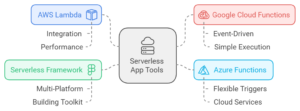
Tools and Platforms for Development
It’s important to pick the right tools for your serverless app. Here are some top choices:
- AWS Lambda: This service lets you run serverless functions with great integration and performance.
- Google Cloud Functions: It provides a simple way to run code in response to events.
- Azure Functions: Offers flexible triggers for different cloud services.
- Serverless Framework: A toolkit for building serverless apps on various cloud platforms.
Best Practices for Developing Serverless Apps
Following best practices makes serverless apps easier to maintain and use. Consider these approaches:
- Use a microservices architecture. It breaks the app into smaller services.
- Design the app to be event-driven. This way, it responds quickly to changes or user actions.
- Keep an eye on how the app performs. This helps spot and fix slow parts.
- Add good logging. It makes finding and solving problems faster.
With the right tools and practices, building serverless apps can be efficient and cost-saving. They scale well and save resources.
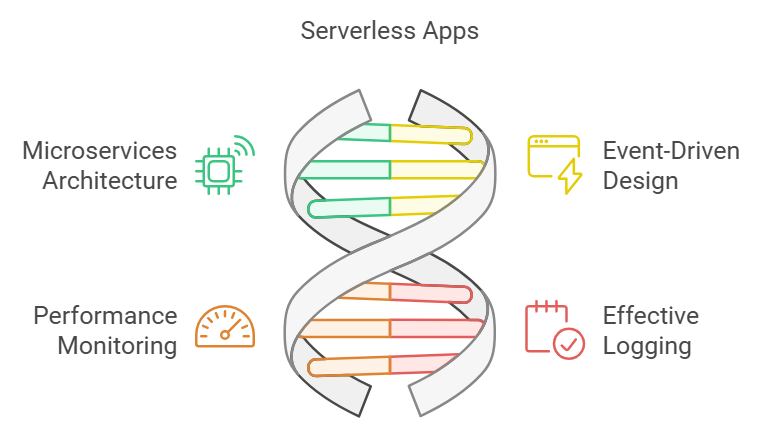
Benefits of Serverless Computing for Businesses
More and more businesses see the value in serverless computing. It’s a new way that helps companies grow and become more efficient. Without the need to manage servers, firms can move faster and adapt quickly. This means they can get their applications out to the market faster and meet customer needs better.
Increased Agility and Speed to Market
Serverless computing speeds things up for businesses. Without the need to manage servers, teams can spend more time creating and deploying applications. This lets companies introduce new services faster than ever before.
Reduced Operational Overhead
Going serverless also cuts down on costs. It automates a lot of the work that used to be done by hand. This means companies spend less on hardware and upkeep. So, they can use their money and people for more important projects. This is key in staying ahead in today’s fast-paced world.
| Aspect | Traditional Computing | Serverless Computing |
| Server Management | Requires significant IT resources | Minimal management needed |
| Time to Deploy | Longer due to setup and maintenance | Faster, often immediate |
| Cost Structure | Fixed costs with maintenance and scaling | Pay-per-use model |
| Focus Areas | Infrastructure management | Application development and strategy |
Serverless computing is an exciting shift in cloud services because it removes the need to manage servers, allowing developers to focus entirely on coding. This approach brings significant advantages, like cost savings and scalability, making it an attractive choice for many companies. As businesses in sectors like e-commerce, healthcare, and finance recognize its value, serverless is quickly gaining traction.
More than just a trend, serverless computing is set to play a key role in the future of cloud services. By adopting serverless, companies can accelerate their digital transformation, boosting their agility and competitiveness in a fast-paced world and positioning themselves for success in the digital era.
Ready to innovate and transform your business? Say hello to CodeBeavers!
If you are looking for ways to bring your product or app ideas to life? We’ve got your back. CodeBeavers has the tools and engineers you need to make your projects come alive. With CodeBeavers, you’ll be able to build faster than ever, deploy code with ease, and scale like never before. Send us your requirements now, and let’s start winning together.


